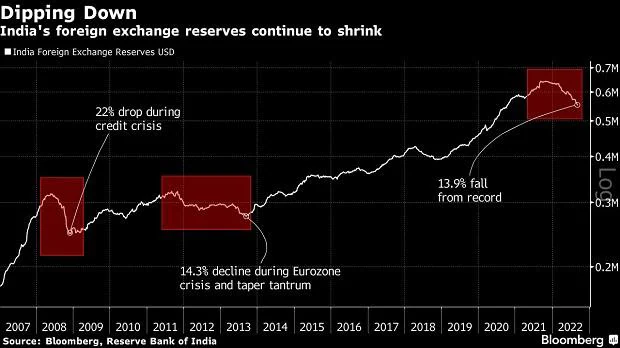Govt’s intervention to protect rupee takes large bite from record reserves
India’s intervention to protect the rupee is running down currency reserves at a rate that’s poised to eclipse the drawdown during turmoil a decade ago.
While economists and the Reserve Bank of India aren’t ringing any alarm bells just yet, investors are watching closely given the rupee’s slump to an all-time low last month and the risk of a widening in the current account deficit.
Given a steady buildup in the reserves through to their peak last year, they remain at a much healthier level than during the previous period that covered part of the Eurozone crisis and the taper tantrum triggered by the Federal Reserve.
Also Read: RBI net-sold $19.05 billion in forex market in July to protect rupee
That crisis saw the rupee tumble almost 30% against the greenback between September 2011 and September 2013, making it one of the worst-performing emerging-markets currencies at the time. It’s dropped about 6.8% against the greenback in 2022, which is a much smaller loss than that of most of its peers.
Still, the central bank does need to be mindful that foreign exchange reserves have declined by $90 billion from their September 2021 peak of $641 billion — a drop of 13.9%, according to RBI data. The drop in the two years a decade ago was 14.3%.
“Falling FX reserves, persistently-high commodity prices, limited exchange rate pass-through to inflation and elevated INR valuations will likely tilt the balance towards a less interventionist FX policy in coming months,” Madhavi Arora, lead economist at Emkay Global Financial Services Ltd., said in a note.
The drawdown has reduced the import cover these reserves provide to nine months, still above a standard benchmark of three months, but far below the 19 months at the beginning of 2021.

Meanwhile, economists at Citigroup Inc. have forecast India’s current account deficit to reach 3.9% of gross domestic product in the fiscal year through March, versus 1.2% last year. This would be expected to weigh on the rupee and increase pressure on the RBI to intervene to reduce the sharpness of declines.
So far though, central bank governor Shaktikanta Das maintains that the level of reserves and the banking system are both healthy and well placed to handle any external shocks.
The RBI has said it expects the country’s current account deficit to stay within 3% of GDP, which it judges to be sustainable amid softening global fuel, food and fertilizer prices while portfolio flows and exports pick up.
 Loan, Personal Loan, Home Loan, Business Loan,Loans in India Loan in India, Personal Loan, Home Loan, Business Loan, Loans in India,Loan Finance,Loan in India, Get Instant Personal Loan,Home Loan, Business Loans in India
Loan, Personal Loan, Home Loan, Business Loan,Loans in India Loan in India, Personal Loan, Home Loan, Business Loan, Loans in India,Loan Finance,Loan in India, Get Instant Personal Loan,Home Loan, Business Loans in India